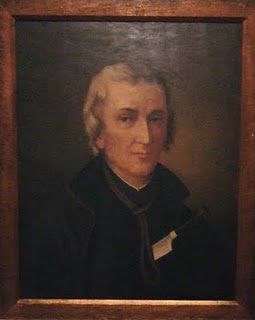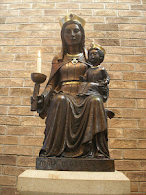| 17th century icon, Madonna and Child |
Christmas of 1678 couldn’t have been a joyful one
for Fr David Lewis S J. Details of that
Christmas are scant but we do know for certain that it was the priest’s last
Christmas on earth! As he prepared to
celebrate Mass on Sunday morning, 17th November, Fr Lewis was
arrested at Llantarnam. He was
incarcerated in Monmouth Gaol. The
Justice of the Peace, John Arnold, who had feigned friendship with Fr Lewis,
promised that he would not allow him to be treated with “any incivility or severity”.
Alas, the promise proved to be as false as the friendship. That very same day, the perfidious Arnold had
ordered that a strict watch should be kept over the prisoner, who was guilty of
high treason, i.e., he was a Catholic
priest!
Christmas found Fr Lewis in Monmouth Gaol, where a
friend of the Jesuit had paid 14/ a week to provide him with a good lower room,
a bed, linen, fire and a candle. Officially,
Fr Lewis was in Solitary Confinement but the Under keeper of the Gaol allowed
friends to visit him in his cell by day.
Early in December, the Lords ordered an
investigation of the Jesuit College of St Francis Xavier at the Cwm, where Fr
Lewis had been Superior. Just before
Christmas, the Bishop of Hereford, Herbert Croft, led a raid on the Cwm. He had the enthusiastic help of John Arnold,
John Scudamore and Charles Price. The
buildings were ransacked and all books, papers and property confiscated. Some of the books stolen from the Cwm are
today in the library of Hereford Cathedral.
Croft reported that he had found “two
horse-loads of books in an adjoining Pig Cot covered with straw, also a great
store of divinity books (but they are not yet brought to me, it being Christmas
holy days, but they remain in a safe hand) many whereof are written by the principal
learned Jesuits”.
On 4th December, Fr Philip Evans, the
youngest of the Jesuit missioners in South Wales, was arrested. He was imprisoned in Cardiff Castle where he
was kept in Solitary Confinement for three weeks. After this time, the Governor was persuaded
to allow Fr Evans and a secular priest, Fr John Lloyd, to share a cell. Other priests had been arrested and some had
died of hardship and exposure.
All of this distressing news would have been
conveyed to Fr Lewis by the friends who visited him in Monmouth Gaol.
On the Sunday morning of Christmas week, Fr Lewis
was visited in his cell by several magistrates who questioned him about William
Bedloe’s allegation that he had supplied information about the Marquis of
Worcester’s Agent’s complicity in the Popish Plot. Fr Lewis deposed that he had neither spoken
to nor corresponded with the informer.
He further testified that he had never even heard of the Plot until it
became common knowledge throughout the land.
His deposition was sent to London but no more was heard of it.
So passed what was to be the last Christmas of Fr
David Lewis. Early in 1679, the new High
Sheriff, James Herbert, decided to move the County Gaol from Monmouth to
Usk. On 13th January, a
bitterly cold and miserable day, Fr Lewis was transferred to Usk Gaol to await
his fate. Later that year, in the lovely
month of August, Fr David Lewis was martyred at Usk. On 25thOctober 1970 he was canonised by Pope Paul VI as one of the Forty Martyrs of England and Wales .

.JPG)



.jpg)

.JPG)



.JPG)
.JPG)
.JPG)


.JPG)









.JPG)

.JPG)



.JPG)
